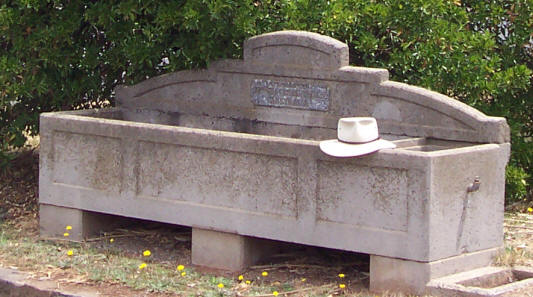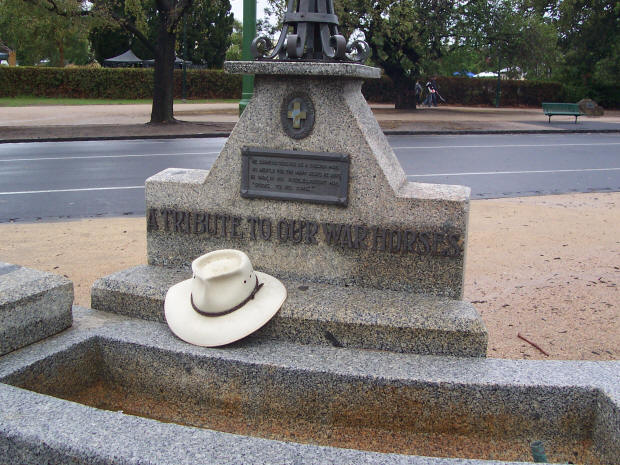Two Horse Troughs
This article was first published in the White Hat
Melbourne Newsletter No.247 on 13 December 2007

The walking tour has stopped while the guide tells them about �this
lovely old building dating back to the elegant days of Melbourne�. It is
actually a faked-up fa�ade in Ye Olde Tea Shoppe Style that was whacked on
in the 1950s but always proves popular with tourists. At the back of the
tour group and completely unnoticed is a humble horse trough. It is made
from cheap concrete and has the small inscription �Annis & George Bills�. In
early Melbourne the horse was the car, motorbike, bus and truck of Melbourne
while the bullock was the semi-trailer and road train. At one stage,
Melbourne had over a million working horses and they helped shape Melbourne.
The low bridges over the Yarra
which were to eventually block any serious shipping out of the city were
created to accommodate the horses pulling heavy loads that would not have
been able to negotiate the steep incline of a high arched bridge.
A working horse needs over 50 litres of water per day. During winter
there were plenty of watercourses and there was always Lake Cashmore in the
city, but come summer the horses were often driven many hard miles between
available drinks. Annis and George Bills were philanthropists who were
concerned about the welfare of horses and other animals and set about
providing mass produced horse troughs across Australia. The little horse
trough seems to me to have a much more important story to tell than the
1950s fa�ade but I am in the minority because another walking tour is
waiting impatiently for the current one to move along so that they can learn
about the �lovely old building� - and judging by the narration
style of the guides, if the trough is noticed by a participant, the guide is
likely to be refer to it as a "horse hydration station".

Across town the bus has paused briefly while the tour guide explains the
significance of the buildings in the distance. Nobody notices the horse
trough in the foreground. It once stood in St Kilda Road but has now been
shifted here. In WWI horses provided much of the �grunt� for the Australian
troops, hauling provisions, heavy artillery and other necessities.
Particularly prized were the Australian bred Station Horses and Walers
(short for New South Walers). Bred for the harsh conditions of outback
stations they were well adapted for desert work. When the Australian Light
Horse was instructed to take Beersheba they had to cross a tract of
waterless desert. Thirsty men and horses arrived within sight of Beersheba
protected by Turkish artillery. They decided the only option was to charge.
The sturdy Walers were not only capable of carrying a heavy load but could
move from a trot to a gallop without the intermediate canter. The speed of
the Australian�s charge surprised the Turks who were not able to adjust the
range of their artillery in time before the Australians were �under the
guns� and a combination of men and horses had taken Beersheba in one of
Australia�s great military victories. Due to quarantine, none of the Walers
ever returned to Australia.
The guide continues to read from her guidebook while none notice the
horse trough in front of them which was erected to the memory of war horses.
Its simple inscription reads:
"He gains no crosses as a soldier may,
no medals for the many
risks he runs,
he only, in his puzzled, patient way,
'sticks to
his guns'"
Here at White Hat we may be a little strange but we often find that it is
the simple unobtrusive monuments that can give more of a feeling for
Melbourne rather than the ones you find in the guide books and the official
tourist guides.
|
|
Copyright © 1995 - 2026
White Hat.
|
Other articles in the series Seven Monuments of Melbourne: